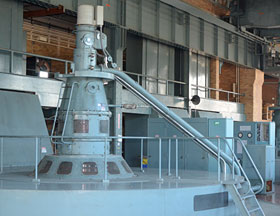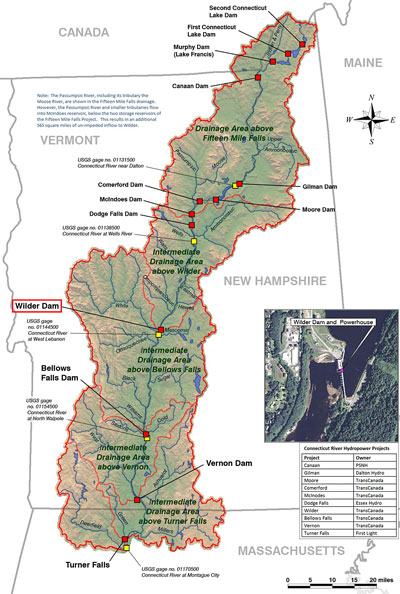Wilder Project FERC No. 1892
Location

The Wilder Project, FERC No. 1892, is located on the Connecticut River at river mile 217.4 and extends upstream approximately 46 miles. The dam and powerhouse is approximately 1.5 miles upstream of the White River and approximately 7 miles downstream of the Ompompanoosuc River.
State or Territory: New Hampshire and VermontCounty: NH – Grafton, VT – Orange and Windsor
Township or nearby town: NH – Lebanon, VT – Hartford
The installed capacity of the Project is: 35,600 kW.
Project Works
Project works consist of:
- A concrete gravity dam 59 feet high, comprised of a 232-foot-long non-overflow section and a 526-foot-long spillway section with six tainter gates, four flashboard stanchion bays, and two skimmer gates; and two earthen embankments totaling 580 feet;
- Wilder reservoir, extending 45-miles upstream, having a surface area of 3,100 acres at normal pool elevation of 385 feet msl;
- a powerhouse containing two 16,200-kW generating units, and one 3,200-kW unit;
- transmission interconnection facilities consisting of three generator leads to the 13.8-kV bus;
- fish passage facilities; and
- appurtenant facilities.
History and Amendments
On April 22, 1944, the original Wilder Project license was issued to the Bellows Falls Hydro-Electric Corporation by the Federal Energy Regulatory Commission (FERC) with the intent to construct a new integrated powerhouse and concrete dam 0.5 mile downstream of an existing dam, powerhouse and paper mill complex known as the Olcott Falls mill (see section 3.12, Cultural Resources of the Pre-Application Document (PAD)). After the July 28, 1948, license transfer to New England Power Company, reconstruction of the present-day Wilder Project began in March 1949 and commenced operations on December 1, 1950. The original license for the Project expired on June 30, 1970, and the Project operated under annual licenses until the license was renewed on December 10, 1979. A December 11, 1985, amendment authorized the construction of a fish ladder, powerhouse expansion and a third 3.2 megawatt (MW) unit.
On October 5, 1978, FERC approved a settlement agreement concerning fish passage facilities for American shad and Atlantic salmon at the Wilder Project, and at two downstream projects - Bellows Falls (Project No. 1855) and Vernon (Project No. 1904). The settlement was executed on December 30, 1977, among the Licensee; the states of Massachusetts, Connecticut, New Hampshire, and Vermont; U.S. Fish and Wildlife Service (FWS); and four non-governmental organizations (the Environmental Defense Fund, the Massachusetts Public Interest Research Group, Inc., For Land’s Sake, and Trout Unlimited). The settlement called for staged design, construction, and operation of passage facilities at the three projects, with Wilder’s construction and operation occurring after completion of the two fishways downstream. The installation of a new 3.2 MW unit harnessed the required minimum flow for additional generation while utilizing the unit discharge for ladder entrance attraction water supply (see section 2.3.1 of the PAD for more information). Construction of the fish ladder and third generating unit was completed in 1987.
On July 26, 1990, the Licensee entered into a Memorandum of Agreement with the Connecticut River Atlantic Salmon Commission (CRASC) for permanent downstream fish passage facilities for the Wilder, Bellows Falls, and Vernon projects. Downstream fish passage at Wilder uses an existing surface gate adjacent to the fish ladder exit and powerhouse without structural modification or license amendments. Downstream passage at the Wilder Project began in 1988.
On February 27, 1998, FERC approved the transfer of the license from New England Power Company to USGen New England, Inc. Under a multi-license amendment dated November 19, 1998, regional electrical transmission facilities were removed from the Project, including step up transformers. At that time, the station was automated and began operations via remote control from the Connecticut River Control Center in Wilder, Vermont.
On January 24, 2005, FERC approved the transfer of the license to TransCanada Hydro Northeast Inc.
On April 19, 2017, Great River Hydro, LLC acquired all of TransCanada's New England hydroelectric power portfolio which included the Wilder Project.
Relicensing
About Great River Hydro
Great River Hydro is New England’s largest conventional hydropower generator. Go to www.greatriverhydro.com for more information.
© 2024 Great River Hydro, LLC

